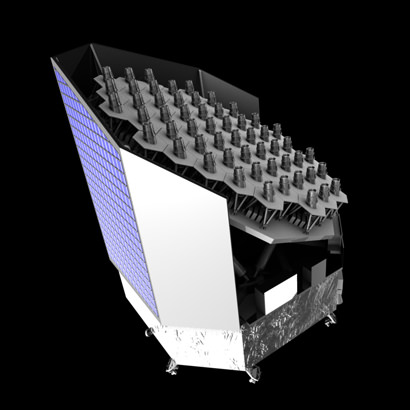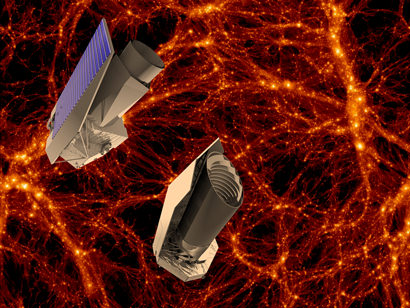Key questions relevant to fundamental physics and cosmology, namely the nature of the mysterious dark energy and dark matter (Euclid); the frequency of exoplanets around other stars, including Earth-analogs (PLATO); take the closest look at our Sun yet possible, approaching to just 62 solar radii (Solar Orbiter) … but only two! What would be your picks?
These three mission concepts have been chosen by the European Space Agency’s Science Programme Committee (SPC) as candidates for two medium-class missions to be launched no earlier than 2017. They now enter the definition phase, the next step required before the final decision is taken as to which missions are implemented.
These three missions are the finalists from 52 proposals that were either made or carried forward in 2007. They were whittled down to just six mission proposals in 2008 and sent for industrial assessment. Now that the reports from those studies are in, the missions have been pared down again. “It was a very difficult selection process. All the missions contained very strong science cases,” says Lennart Nordh, Swedish National Space Board and chair of the SPC.
And the tough decisions are not yet over. Only two missions out of three of them: Euclid, PLATO and Solar Orbiter, can be selected for the M-class launch slots. All three missions present challenges that will have to be resolved at the definition phase. A specific challenge, of which the SPC was conscious, is the ability of these missions to fit within the available budget. The final decision about which missions to implement will be taken after the definition activities are completed, which is foreseen to be in mid-2011.
[/caption]
Euclid is an ESA mission to map the geometry of the dark Universe. The mission would investigate the distance-redshift relationship and the evolution of cosmic structures. It would achieve this by measuring shapes and redshifts of galaxies and clusters of galaxies out to redshifts ~2, or equivalently to a look-back time of 10 billion years. It would therefore cover the entire period over which dark energy played a significant role in accelerating the expansion.
By approaching as close as 62 solar radii, Solar Orbiter would view the solar atmosphere with high spatial resolution and combine this with measurements made in-situ. Over the extended mission periods Solar Orbiter would deliver images and data that would cover the polar regions and the side of the Sun not visible from Earth. Solar Orbiter would coordinate its scientific mission with NASA’s Solar Probe Plus within the joint HELEX program (Heliophysics Explorers) to maximize their combined science return.

PLATO (PLAnetary Transit and Oscillations of stars) would discover and characterize a large number of close-by exoplanetary systems, with a precision in the determination of mass and radius of 1%.
In addition, the SPC has decided to consider at its next meeting in June, whether to also select a European contribution to the SPICA mission.
SPICA would be an infrared space telescope led by the Japanese Space Agency JAXA. It would provide ‘missing-link’ infrared coverage in the region of the spectrum between that seen by the ESA-NASA Webb telescope and the ground-based ALMA telescope. SPICA would focus on the conditions for planet formation and distant young galaxies.
“These missions continue the European commitment to world-class space science,” says David Southwood, ESA Director of Science and Robotic Exploration, “They demonstrate that ESA’s Cosmic Vision programme is still clearly focused on addressing the most important space science.”
Source: ESA chooses three scientific missions for further study


If I had to pick two, it would be the exoplanet and the dark matter ones.
We already know a great deal about our Sun, and it’s not going anywhere.
Dark matter / energy is frontier science, and there is a LOT we don’t know (or even if the theories are entirely accurate), and learning more about planets orbiting other stars leads people to think about finding E.T. which always captures people’s imaginations… as well as promotes scientific discovery.
Given Obama’s apparent view that NASA should become a glorified weather centre, and leave manned space flight to Branson, I hope ESA show some balls and do the right thing.
A fantastic overview of the science hoped to be accomplished by the SDO. It should prove quite interesting when the field-of-view of the SDO encompasses SGR A*, the 3.6 Million solar mass Supermassive Black Hole in the center of our Milky Way Galaxy in the same field. Electric Cosmology “experts” will no doubt proffer pseudoscientific explanations as to why this is so. They’re just beating a dead horse. Time to let it go.
This is a tough call. As one interested in the big picture I would choose the Euclid to map the DM universe. Between PLATO and the Solar Orbiter I frankly might have to go with the solar orbiter. The clever orbital energy transfers increase the inclination of the spacecraft so we can look at the poles of the sun. This is important in order to understand the complex physics of the sun.
LC
I’m with StockportJambo…
PLATO answers a question on the path to “are we alone?”.
EUCLID answers a question on the path to “how does the universe work”.
Both big fat fundamental questions.
Solar Orbiter is, well, sort of egocentric… Interesting, yes, fundamental, no.
That IS tough – but I’d be picking the DM/DE mission and the exoplanet mission.
Indeed – the Sun will continue to yield very interesting secrets for as long as we continue to send probes up to study it, but that’s the thing – there are so many great Solar missions up at the moment that I feel there are other areas that require attention, so that we can push back the frontiers there too. There are no greater or more significant problems in science at the moment than what the nature of DM/DE is and what the range and variety of exoplanet characteristics are…
Let’s gun for the big juicy problems!
This one is a no brainer:
Mission one should be Plato.
Mission two should hand over their budget to mission one. (=
@ Uncle Fred
LOL
You and I think pretty much the same on this issue =)
Hm.
Euclid is clear.
Second one? I think I’d vote for the solar orbiter. Our understanding of the physics of the sun is all but complete. And since our civilization depends critically on electrical power we are quite vulnerable to an intense solar storm. So, early warning is everything. And for this we need to understand how the sun, and especially CMEs work.
Solar Orbiter, I have always wanted a mission to get right in close to our nearest star, the more we learn about this star the more we learn about all stars.
PLATO for the second mission but if i could be greedy I’d say Solar Orbiter part 2 for the second mission.
This is tough [surprise, surprise] and I’m not sure there is a rational answer outside of ESA process.
[For example, what is the question? 😀
If it’s just launching two out of three missions, fine, use a random selection.]
First, there is the wish list approach.
I now I should push for solar physics as I’m in an environment of astrophysicists that shows me how our understanding of the sun and planets interactions with it (and themselves) are less than complete. And this is serious physics, from very basic out to esoteric applied.
But there is another rational argument here as well, the joint program is an opportunity that shouldn’t be missed. (The same argument goes for supporting SPICA.) As other commenters say, space itself won’t go anywhere.
So, taken care of immediate contingency, a tactics perspective, what would I wish for next, a strategic perspective? [Yes, it’s backwards, but that’s how contingency works at times.]
Interesting as planet formation and habitability is to me, I believe that is pretty much covered by ongoing and upcoming missions. Or at least, I hope so. DM/DE is where the questions stop at right now, so Euclid.
Second, there is the practical approach. This will be decided by matureness in the ESA process, unless I’m mistaken. (I.e. roughly inverse economic and scientific risk taken.) That is all internal data, so my pick is neither here nor there.
PLATO seems to be just ESA’s copy of NASA’s Kepler, though presumably staring at a different star field. Is it worth it in the face of such good competition?
Easy. Everyone and their dog are looking for exoplanets. There are other missions planned for that, and it’d be silly to start more before the results from Kepler are in. 2011 is certainly too early.
Dark Matter and the Sun are far more interesting. And now that Ulysses is dead, we need a replacement to investigate the Sun.
In fact, the Sun mission would be my preferred one even if limited to one mission. The Sun affects us far more than DM and the potential for life elsewhere. The data we can get there might be invaluable for predicting spaceweather, ensuring the safety of our astronauts, satellites and powergrid.
Plus it’s just damn cool!
Go with studying the sun and the planets. Those are the easiest to observe and have the most benefits.
StockportJambo Says: We already know a great deal about our Sun, and it’s not going anywhere.
No. We don’t know a lot about the sun. We know zilch, despite what the textbooks say.
On this ESA page you can read a summary of the six candidate M-class Cosmic Vision missions.
Four made the cut (Solar Orbiter, Euclid, PLATO, and SPICA).
The two which didn’t are Cross Scale and Marco Polo.
The Sun – can’t learn enough about our closest star.
Dark matter – a must know more.